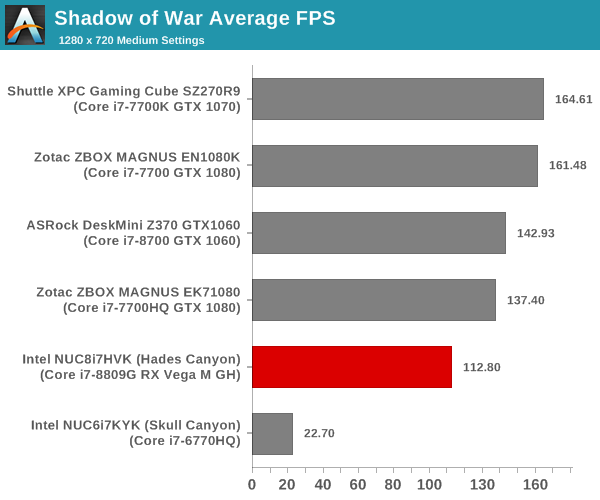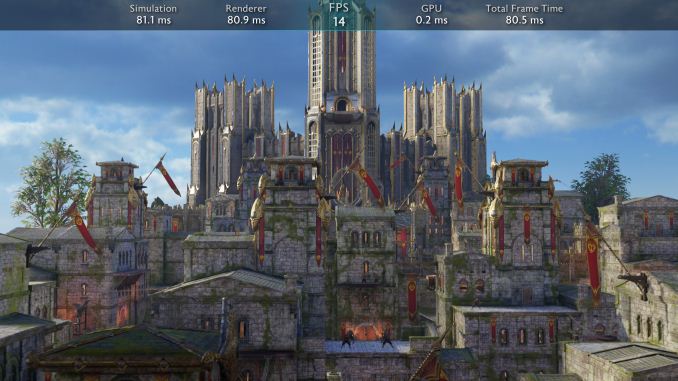Intel NUC8i7HVK (Hades Canyon) Gaming Performance - A Second Look
by Ganesh T S on May 14, 2018 8:01 AM ESTGaming Performance - Middle Earth: Shadow of War
Middle Earth: Shadow of War is an action RPG. In our previous gaming benchmarks suite, we used its prequel - Shadow of Mordor. Produced by Monolith and using the new LithTech Firebird engine and numerous detail add-ons, Shadow of War goes for detail and complexity.
The graphics settings include standard options such as Graphical Quality, Lighting, Mesh, Motion Blur, Shadow Quality, Textures, Vegetation Range, Depth of Field, Transparency and Tessellation. There are standard presets as well. The game also includes a 'Dynamic Resolution' option that automatically alters graphics quality to hit a pre-set frame rate.
We benchmark the game at four different resolutions - 4K, 1440p, 1080p, and 720p. Two standard presets - Ultra and Medium - are used at each resolution, after making sure to turn off dynamic resolution.
| Middle Earth: Shadow of War Performance | |||

Middle Earth: Shadow of War is yet another game that follows the expected template - the Hades Canyon NUC can keep the game playable at 1080p with medium quality settings. However, it can't match up with the other systems equipped with discrete GPUs at any resolution or quality setting.











38 Comments
View All Comments
eva02langley - Monday, May 14, 2018 - link
Well, I think AMD might have wanted to keep their Vega trump card for their own APUs, which I believe is the right thing to do from business standpoint.Anyway, another Intel attempt that comes short of anything except just a proof of concept.
sing_electric - Monday, May 14, 2018 - link
If that's the case, then we haven't seen AMD's solution here.Intel's "G" chips with Vega graphics have HBM2 memory on-package, while AMD's APUs just use system memory. That certainly has cost (and power) advantages, but it also means the APUs don't perform nearly this well, even under ideal circumstances. (On top of that, it looks like a lot of OEMs are using single-channel DDR, and sometimes not even at a high frequency, on their Ryzen APU systems, which
sing_electric - Monday, May 14, 2018 - link
*REALLY kills performance.only1jv - Monday, May 14, 2018 - link
Will there be a review of the DeskMini GTX 1080? I know this article mentions the GTX1060 model but why not the GTX1080?Now I'm really curious to know how the ASRock GTX1080 would stack up against the Zotac ZBOX EN1080K
darkos - Monday, May 14, 2018 - link
why are there no flight simulation tests included? eg: prepar3d or fsx or x-plane ?s3cur3 - Monday, May 14, 2018 - link
If an X-Plane benchmark is something the Anandtech editorial team would be interested in, you can contact me via the email in my profile. The numbers might be more useful after our transition to Vulkan, though.Ian Cutress - Tuesday, May 15, 2018 - link
Our website accounts don't have profiles - can you ping ian@anandtech.com. I'd like to see what we can do.bernstein - Monday, May 14, 2018 - link
interesting product! finally a performance competitive SoC gaming (or 3d work) rig from intel!! just imagine the possibilities if they used coffee lake + vega 64!however the a price/performance ratio on gpu limited tasks :
- compared to a Shuttle XPC Gaming Cube is abysmal
- compared to a Skull Canyon NUC is phenomenal
so while expensive, it's certainly less overpriced than previous intel gaming NUC offerings...
kmmatney - Monday, May 14, 2018 - link
Looks like similar performance to a GTX 1050? or 1050 Ti? Would have been nice to include one of those cards.Yojimbo - Tuesday, May 15, 2018 - link
The difference between the 1050 Ti and the 1060 is quite large. This Intel chip with AMD graphics has a performance between them, but closer to the 1060 than a 1050 Ti, on average. Of course one would have to look closely at one's use case to decide whether it will run closer to a 1060 or to a 1050 Ti.